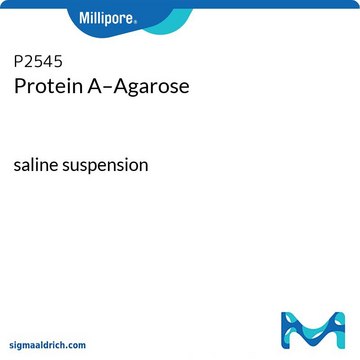P3351
Protein L–Agarose from Peptostreptococcus magnus
recombinant, expressed in E. coli
About This Item
Prodotti consigliati
Ricombinante
expressed in E. coli
Livello qualitativo
Matrice
6% beaded agarose supplied as 50% slurry
Attivazione matrice
cyanogen bromide
Gruppi immobilizzati alla matrice
amino
Capacità
3-10 mg/mL binding capacity
Temperatura di conservazione
2-8°C
Applicazioni
Nota sulla preparazione
Codice della classe di stoccaggio
3 - Flammable liquids
Classe di pericolosità dell'acqua (WGK)
WGK 2
Punto d’infiammabilità (°F)
Not applicable
Punto d’infiammabilità (°C)
Not applicable
Certificati d'analisi (COA)
Cerca il Certificati d'analisi (COA) digitando il numero di lotto/batch corrispondente. I numeri di lotto o di batch sono stampati sull'etichetta dei prodotti dopo la parola ‘Lotto’ o ‘Batch’.
Possiedi già questo prodotto?
I documenti relativi ai prodotti acquistati recentemente sono disponibili nell’Archivio dei documenti.
I clienti hanno visto anche
Protocolli
To determine the molecular weights of protein antigens, to study protein/protein interactions, to determine specific enzymatic activity, to monitor protein post-translational modifications and to determine the presence and quantity of proteins.
Il team dei nostri ricercatori vanta grande esperienza in tutte le aree della ricerca quali Life Science, scienza dei materiali, sintesi chimica, cromatografia, discipline analitiche, ecc..
Contatta l'Assistenza Tecnica.













